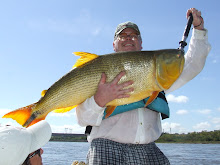


Silver Salmon are found in the Pacific Ocean and the rivers following into it from Northern Japan to the Anadry River, Russia, and from Northern Alaska south to Monterey Bay, California. They were transported into the Great Lakes and into freshwater lakes in Alaska and the U.S. Pacific coast as well as into Argentina and Chile.
Silver Salmon are also known as Coho Salmon. As with most Pacific Salmon they spending the majority of their lives in the Ocean for 4 to 6 yrs where they reach maturity.
An estimated 85 percent of native Pacific silvers return to spawn in the same stream where they began their life. Once entering the freshwater, these salmon will never return back to the ocean and die after spawning is complete.
During the spawning ritual, the male silver tend to turn somewhat darker on the back. During the spawning run a red coloration is exhibited on it's body. The males develop a kype with both the lower and upper jaw being extended where it becomes almost impossible to close it's mouth. Like all Pacific salmon they do not feed once it enters freshwater on the spawning run. They however will constantly hit lures out of instinct.
According to the IGFA, the World Record Silver Salmon is 33lbs 4oz landed by Jerry Lifton on Sep 27 1989 while fishing the Salmon River in Pulaski, New York.
Silver Salmon can be caught in abundance in freshwater streams and river using convential lures such as in-line spinners and pixee spoons. They also are caught by various flies.
Some of the best silver salmon fishing I know of occurs each August and September on the Alaska Peninsula. Here 50 to 75 silvers landed in a day's fishing is possible.
I have fished the Cinder River on the Alaska Peninsula out of Gary LaRose's Pumice Creek Lodge and have experienced fantastic silver fishing. For more information on this fabulous lodge check out http://www.garylarose.com/

No comments:
Post a Comment